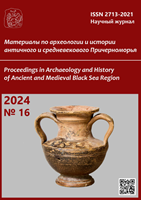Огнестрельное оружие в ногайлинско-казахском героическом эпосе
Firearms in the Noghaic-Kazakh heroic epos
Author(s): O.M. Agatay, Zh.M. Sabitov, Zylikha Omirbekovna Ibadullayeva, N.A. DossymbetovSubject(s): Archaeology, Cultural history, Customs / Folklore, Social history, Cultural Anthropology / Ethnology, Sociology of Literature
Published by: Нижневартовский государственный университет
Keywords: firearms; Turkic heroic epic; Nogai; Kazakh; history of Kazakhstan; Ulus of Jochi;
Summary/Abstract: The article considers the materials of Noghaic-Kazakh heroic epos containing information about various names and peculiarities of firearms use. Earlier these materials have not become the object of special scientific research and have not been translated into foreign languages, including Russian. On the basis of a comprehensive analysis of folklore and written sources, the attempt was made to identify the original names, as well as some circumstances of the appearance and use of firearms by the Noghai, Tatars and Kazakhs of the New Age. Based on the study of collected, systematised and analysed sources, the main terms and phrases used in the Noghaic-Kazakh heroic epic to denote firearms, have been identified and attributed. In particular, it has been established that in the New Age the nomadic warriors of Western and Eastern Desht-i Kipchak: the Crimean steppe, as well as the Kazakh khanates and uluses of the northeastern Caspian and the Aral-Syrdarya regions, Zhetysu, Saryarka and Altai used such varieties of firearms as zenbirek (cannon), top or dop (large-calibre cannon), myltyk (gun), tuzu myltyk (“straight” gun), samkal (shamkhal gun), zhez ayil (jezail gun), kara myltyk (“black” (ordinary?) shotgun), orama myltyk (“wrapped” shotgun), serippeli akberen (“perfect” shotgun with a spring mechanism), shappaly myltyk (shotgun with a trigger), kyrly myltyk (“shotgun with facets” or “faceted shotgun”), musyk kulak myltyk (“a cat’s ear” shotgun), kuldir mamay (kul’dur mamay), kozy kosh (koz-kech), ak myltyk (“white” shotgun). The analysis of the collected and systematised materials has shown that within the framework of a comprehensive analysis of sources, the Noghaic-Kazakh heroic epic can be used to study the military and cultural heritage of the Turkic and Mongolian peoples of Eurasia in the New Age.
Journal: Материалы по археологии и истории античного и средневекового Причерноморья
- Issue Year: 2024
- Issue No: 16
- Page Range: 651-669
- Page Count: 19
- Language: Russian

